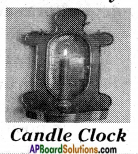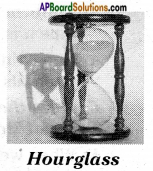 |
| AP Board Class 7 Science Chapter 4 Motion and Time Textbook Solutions PDF: Download Andhra Pradesh Board STD 7th Science Chapter 4 Motion and Time Book Answers |
Andhra Pradesh Board Class 7th Science Chapter 4 Motion and Time Textbooks Solutions PDF
Andhra Pradesh State Board STD 7th Science Chapter 4 Motion and Time Books Solutions with Answers are prepared and published by the Andhra Pradesh Board Publishers. It is an autonomous organization to advise and assist qualitative improvements in school education. If you are in search of AP Board Class 7th Science Chapter 4 Motion and Time Books Answers Solutions, then you are in the right place. Here is a complete hub of Andhra Pradesh State Board Class 7th Science Chapter 4 Motion and Time solutions that are available here for free PDF downloads to help students for their adequate preparation. You can find all the subjects of Andhra Pradesh Board STD 7th Science Chapter 4 Motion and Time Textbooks. These Andhra Pradesh State Board Class 7th Science Chapter 4 Motion and Time Textbooks Solutions English PDF will be helpful for effective education, and a maximum number of questions in exams are chosen from Andhra Pradesh Board.Andhra Pradesh State Board Class 7th Science Chapter 4 Motion and Time Books Solutions
| Board | AP Board |
| Materials | Textbook Solutions/Guide |
| Format | DOC/PDF |
| Class | 7th |
| Subject | Maths |
| Chapters | Science Chapter 4 Motion and Time |
| Provider | Hsslive |
How to download Andhra Pradesh Board Class 7th Science Chapter 4 Motion and Time Textbook Solutions Answers PDF Online?
- Visit our website - Hsslive
- Click on the Andhra Pradesh Board Class 7th Science Chapter 4 Motion and Time Answers.
- Look for your Andhra Pradesh Board STD 7th Science Chapter 4 Motion and Time Textbooks PDF.
- Now download or read the Andhra Pradesh Board Class 7th Science Chapter 4 Motion and Time Textbook Solutions for PDF Free.
AP Board Class 7th Science Chapter 4 Motion and Time Textbooks Solutions with Answer PDF Download
Find below the list of all AP Board Class 7th Science Chapter 4 Motion and Time Textbook Solutions for PDF’s for you to download and prepare for the upcoming exams:7th Class Science 4th Lesson Motion and Time Textbook Questions and Answers
Improve Your Learning
Question 1.
State whether the following statements are True or False. Rewrite the wrong statements correctly.
a) A body can be at rest and in motion at the same time in relation to the same set of surroundings.
b) A passenger flying in an airplane is at rest with respect to the airport and moving with respect to other passengers.
c) The wheels of a train are in rotatory motion as well as in translatory motion, when it moves.
Answer:
a)
- A body can be at rest when it is not moving in relation to the set of surroundings.
- A body can be at motion when it is in motion at the same time relative to, the set of surroundings.
b)
- A passenger flying in an airplane is at rest with respect to other passengers.
- A passenger flying in an airplane is moving with respect to the airport.
c) The wheels of a train are in rotatory motion as well as in translatory motion when it moves.
Question 2.
John tied a stone to a string and whirled it around. What type of motion do you find there?
Answer:
When a stone is tied to a string and whirled it around, we find rotatory motion in it.
Question 3.
What is common to the following? The motion of the propeller of a flying helicopter, the minute hand of a watch, the tape of a cassette recorder.
a) All are examples of translatory motion.
b) All are examples of oscillatory motion.
c) All are examples of rotatory motion.
d) All are examples of periodic motion.
Answer:
All are examples of rotatory motion.
Question 4.
Which of the following is not an oscillatory motion?
a) Motion of the hammer of an electric bell.
b) Motion of your hands while running.
c) Motion of a child on a see-saw.
d) Motion of a horse pulling a cart.
Answer:
The motion of a horse pulling a cart is not an oscillatory motion.
Question 5.
Arun completed a 100-meter race in 16s, while Karthik finished it in 13s. Who ran faster?
Answer:
- Karthik ran faster.
- The same distance 100 meter race is completed in 13s by Karthik in a short interval of time, compared to 16s as completed by Arun.
- So Karthik ran faster.
Question 6.
I. A train runs from New Delhi to Hyderabad. It covers first distance of 420 km in 7 hrs. and next distance of 360 km in 6 hrs.
II. Gopi takes part in a car race. He drives a distance of 70 km each in the first, second and third hours.
Which of the following statements is true?
a) I is an example of uniform motion and II is an example of non-uniform motion.
b) I is an example of non-uniform motion and II is an example of uniform motion.
c) I and II are examples of uniform motion.
d) I and II are examples of non-uniform motion.
Answer:
a) I is an example of uniform motion and II is an example of non-uniform motion. This statement is not true.
b) I is an example of non uniform motion and II is an example of uniform motion. This statement is true.
c) I and II are examples of uniform motion. This statement is not true.
d) I and II are examples of non-uniform motion. This statement is not true.
Question 7.
Write the motion of different parts of a bicycle while it is in motion.
a) the wheel
b) the cycle chain
c) the pedal with its arm
d) the movement of the feet pedaling
e) the movement of the rider along with the bicycle.
Answer:
a) Rotatory motion
b) Rotatory motion
c) Rotatory motion
d) Oscillatory motion
e) Translatory motion
Question 8.
Which of the following statements is correct?
a) The basic unit of time is second.
b) Every object’s motion is uniform.
c) Two cars move for 5 minutes and 2 minutes respectively. The second car is faster because it takes less time.
d) The speed of a car is expressed in km/h.
Answer:
a) This statement is correct.
b) This statement is not correct.
c) This statement is not correct.
In the statement distance covered by the cars is not mentioned.
d) This statement is correct.
Question 9.
The basic unit of speed is
A) km/min
B) m/min
C) km/h
D) m/s
Answer:
D) m/s
Question 10.
The correct relation between speed, distance and time is
A) Speed = distance/time
B) Speed = time/disatnce
C) Speed = distance × time
D) Distance = speed/time
Answer:
A) Speed = distance/time
Question 11.
The distance between two stations is 240 km. A train takes 4 hrs to cover this distance. Calculate the speed of the train.
Answer:
Distance between the two stations = 240 km
Time taken by the train to travel this distance = 4 hrs
Speed = Distance travelled Time = 2404 = 60 km/hr
Question 12.
A train travels at a speed of 180 km/h. How far will it travel in 4 hours?
Answer:
Speed of the train = 180 km/h
Time of travel = 4 hours
Distance travelled = ?
Distance travelled Time = Speed
∴ Distance travelled = speed × time = 180 km/hr × 4h = 180𝑘𝑚ℎ × 4h = 720 km
Question 13.
When do you say an object is in rotatory motion?
Answer:
1) Motion of all particles of a moving object follow a circular path with respect to a fixed centre of axis of rotation.
2) Then the motion of the object is said to be in rotatory motion.
Question 14.
Can an object possess translatory and rotatory motion at the same time? Give an example.
Answer:
- An object can possess both translatory and rotatory motions at the same time.
- The wheel of a cycle during movement will have both rotatory and translatory motions.
- The wheel rotates (rotatory motion) and at the same time moves forward (Translatory motion).
Question 15.
Make a collection of action pictures showing living and non living things in motion. Paste them neatly in a scrap book. Under each picture write the type of motion the picture shows.
Answer:
Question 16.
In a sewing machine used by tailors, mention the type of motion of sewing machine’s parts when it runs.
a) the wheel b) the needle c) the cloth.
Answer:
a) The motion of the wheel is rotatory motion.
b) The motion of the needle is oscillatory motion
c) The motion of the cloth is translatory motion.
Question 17.
Gather the information about the apparatus used to measure time in olden days.
Answer:
Candle Clock: A candle clock is a thin candle with consistently
spaced markings (usually with numbers), that when burned, indicate the passage of periods of time. While no longer used today, candle clocks provided an effective way to tell time indoors, at night, or on a cloudy day.
Hourglass: An hourglass (sandglass, sand timer, sand clock, egg timer) measures the passage of a few minutes or an hour of time. It has two connected vertical glass bulbs allowing a regulated trickle of material from the top to the bottom. Once the top bulb is empty, it can be inverted to begin timing again.

AP Board Textbook Solutions PDF for Class 7th Science
- AP Board Class 7
- AP Board Class 7 Science
- AP Board Class 7 Science 1st Lesson Food for Health
- AP Board Class 7 Science 2nd Lesson Nature of Substances
- AP Board Class 7 Science 3rd Lesson Nutrition in Organisms
- AP Board Class 7 Science 4th Lesson Respiration and Circulation
- AP Board Class 7 Science 5th Lesson Motion and Time
- AP Board Class 7 Science 6th Lesson Electricity
- AP Board Class 7 Science 7th Lesson Reproduction in Plants
- AP Board Class 7 Science 8th Lesson Wonders of Light
- AP Board Class 7 Science 9th Lesson Heat, Temperature and Climate
- AP Board Class 7 Science 10th Lesson Changes Around Us
- AP Board Class 7 Science 11th Lesson Fibres and Fabrics
- AP Board Class 7 Science 12th Lesson Soil and Water
- AP Board Class 7 Science 1st Lesson ఆహారంతో ఆరోగ్యం
- AP Board Class 7 Science 2nd Lesson పదార్థాల స్వభావం
- AP Board Class 7 Science 3rd Lesson జీవులలో పోషణ
- AP Board Class 7 Science 4th Lesson శ్వాసక్రియ – ప్రసరణ
- AP Board Class 7 Science 5th Lesson చలనం – కాలం
- AP Board Class 7 Science 6th Lesson విద్యుత్
- AP Board Class 7 Science 7th Lesson మొక్కలలో ప్రత్యుత్పత్తి
- AP Board Class 7 Science 8th Lesson కాంతితో అద్భుతాలు
- AP Board Class 7 Science 9th Lesson ఉష్ణం, ఉష్ణోగ్రత మరియు శీతోష్ణస్థితి
- AP Board Class 7 Science 10th Lesson మన చుట్టూ జరిగే మార్పులు
- AP Board Class 7 Science 11th Lesson దారాలు – దుస్తులు
- AP Board Class 7 Science 12th Lesson నేల మరియు నీరు
- AP Board Class 7 Science Chapter 1 Food Components
- AP Board Class 7 Science Chapter 2 Acids and Bases
- AP Board Class 7 Science Chapter 3 Animal Fibre
- AP Board Class 7 Science Chapter 4 Motion and Time
- AP Board Class 7 Science Chapter 5 Temperature and Its Measurement
- AP Board Class 7 Science Chapter 6 Weather and Climate
- AP Board Class 7 Science Chapter 7 Electricity Current and Its Effect
- AP Board Class 7 Science Chapter 8 Air Winds and Cyclones
- AP Board Class 7 Science Chapter 9 Reflection of Light
- AP Board Class 7 Science Chapter 10 Nutrition in Plants
- AP Board Class 7 Science Chapter 11 Respiration in Organisms
- AP Board Class 7 Science Chapter 12 Reproduction in Plants
- AP Board Class 7 Science Chapter 13 Seed Dispersal
- AP Board Class 7 Science Chapter 14 Water Too Little To Waste
- AP Board Class 7 Science Chapter 15 Soil Our Life
- AP Board Class 7 Science Chapter 16 Forest Our Life
- AP Board Class 7 Science Chapter 17 Changes Around Us






0 Comments:
Post a Comment